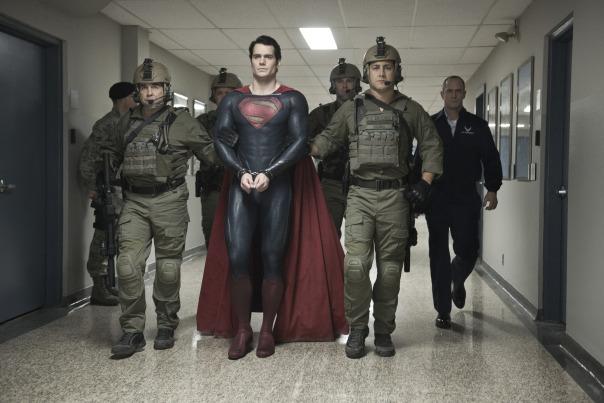
Imagine how our world would react if they came face to face with this…
Man of Steel has divided critics and fans in a manner I would never have expected it to. A tricky character to get right, the man of steel may be the most recognisable of superheros (the grandaddy) but he’s lost his luster in recent years. For this story to work in a modern context, ditching established tradition is one of the few avenues left open. If you’re re-imagining a character like writer David Goyer, Christopher Nolan and director Zack Snyder are here then, as the old saying goes, you can’t make an omelet without breaking a few eggs (or necks).
The film’s plot concerns itself with many things – to a fault. Krypton is dying and Jor-El (Russell Crowe) decides to send his new-born son to another world. In his son’s DNA is, he hopes, the beginnings of a new Krypton free from the failures that blighted his. General Zod (Michael Shannon) and his lieutenant Faora-Ul (Antje Traue), attempt a military coup by taking control of the Codex, a depository that contains information on the genetic future of Krypton. They fail and are imprisoned within the Phantom Zone. Upon Zod’s release he seeks to bring Krypton back and his search takes him to Earth where he finds the now grown up Kal-El/Clark Kent (Henry Cavill).
That’s a lot to take on-board (and there’s more) but Snyder and co are interested in creating a vast mythology for a new generation. MoS isn’t adapting what came before and adding 21st century bells and whistles. This is going back to the core and deciding to start from the very beginning. It lops a backstory on top of an origin story, front-loading the film with exposition that’s nonetheless interesting; building a world brick by brick.
This idea of building from the ground up is reflected in the opening salvo which is huge in scale and sprawling with history. Civil war erupts on Kyrpton as Jor-El seeks to save his son with the planet on the verge of imploding. The imagination on display in this sequence is a world away from Donner’s (now) austere and cool beginnings with Superman: The Movie. So good (and fresh) is this section that it’s quite possibly the best the film has to offer.
Mirroring the structure of Nolan’s Batman Begins, Clark’s arrival on earth flits between two perspectives: the present and the past. The present sees him trying to find a role on Earth, an identity that ties him to humanity. While the scenes set in the past show a young Clark struggling with what he is and how to use his powers. Its in these scenes, with Kevin Costner’s Jonathan Kent and Diane Lane’s Martha Kent as a moral compasses, that the film gains a heart (and a little bit of a brain), making this brittle yet incredibly powerful character more relatable than before.
Costner’s Kent, whether he knows it or not, has the same intentions as Jor-El had and sees Clark’s potential to change the world. All the while realising that Clark can’t be pushed into becoming someone he may not want to be. It boils down to a choice and while it’s inevitable that he will don the suit and cape, the early scenes at least show that its not as easy as walking into the Fortress of Solitude and appearing seconds later as a ready-made superhero like Stars in Their Eyes.
This Superman is as the title implies; a tougher, more resilient version. The charm and playfulness have fallen away to introspection (Cavill’s brow seems permanently furrowed), and a more rustic sensibility not to mention a booming, rhythmic soundtrack courtesy of Hans Zimmer and an imposing physicality that plays out in the film’s second-half.
Its in the second-half where MoS loses its balance. With so much action (most of it spectacular), character interactions are reduced. It certainly harms the relationship between Cavill’s Clark and Amy Adam’s (spiky) Lois Lane. The relationship reaches its required point at the end of the film and yet feels arbitrary and unconvincing. There isn’t enough time to make their relationship a genuine one. Instead what we get a dust-up that’s reminiscent of the Neo/Agent Smith fight in The Matrix Revolutions.
As buildings crumble and streets are ripped apart there’s an emphasis on CG effects that detaches the viewer from the realism Snyder sets up. Its difficult to reconcile a world and a character as fantastic as this with what’s ‘real’ but the action is so over-the-top that any investment naturally begins to wane.
Surprisingly MoS shows another side of Snyder, one that’s not typical of a blockbuster (at least not recently). The breathless action is expected but less so the sensitivity. Restrained, particularly in the middle section, Snyder manages to balance the otherworldly elements without taking the basic human drama for granted. The acting, production design, costuming and overall tone, although you could argue is too dour, ground the world in a realistic millieu. The story takes itself as seriously as it needs to. How would the world react to an alien? Who knows, but this ‘feels’ right and Clark’s quest to find his purpose is given enough weight before it succumbs to action beats.
There’s a multitude of ways this film could have turned out, but this approach feels brave and adventurous. Forging ahead with a new take on an old hero and making him relevant, interesting even.
Flawed? Most definitely. But this film brings new insight to a character lost in time. He’s not quite Superman yet, but he’s well on his way.
8/10
